Inland Flood Analysis in Irrigated Agricultural Fields Including Drainage Systems and Pump Stations
Abstract
1. Introduction
2. Materials and Methods
2.1. Inland Flood Analysis in Agricultural Fields
2.2. SWMM
2.3. K-Flood
3. Study Event and Model Setting
3.1. Study Event
3.2. Model Setting
4. Result and Discussion
4.1. Result for Previous Event
- TPR (true positive rate) was calculated to be 0.565, indicating that out of the total area predicted as ‘Positive’ for flooding in the model (1.62 km2), 0.91 km2 was correctly identified as flooded.
- FPR (false positive rate) was calculated to be 0.21, indicating that out of the total area predicted as ‘Negative’ for flooding in the model (4.56 km2), 0.96 km2 was incorrectly identified as flooded.
- Accuracy represents the proportion of correctly predicted ‘True’ and ‘False’ flooded areas compared to the total flooded area, which was calculated to be 0.731.
4.2. Scenario Based Analysis
5. Conclusions
Author Contributions
Funding
Data Availability Statement
Acknowledgments
Conflicts of Interest
References
- IPCC. Climate Change 2023 Synthesis Report. Contribution of Working Groups I, II and III to the Sixth Assessment Report of the Intergovernmental Panel on Climate Change; IPCC: Geneva, Switzerland, 2023. [Google Scholar]
- Global Network Against Food Crises. Global Report on Food Crises 2023. Food Security Information Network. Available online: https://www.fsinplatform.org/global-report-food-crises-2023 (accessed on 17 March 2025).
- Schilling, K.E.; Gassman, P.W.; Kling, C.L.; Campbell, T.; Jha, M.K.; Wolter, C.F.; Arnold, J.G. The potential for agricultural field use change to reduce flood risk in a large watershed. Hydrol. Process. 2014, 28, 3314–3325. [Google Scholar] [CrossRef]
- Antolini, F.; Tate, E.; Dalzell, B.; Young, N.; Johnson, K.; Hawthorne, P.L. Flood risk reduction from agricultural best management practices. JAWRA J. Am. Water Resour. Assoc. 2020, 56, 161–179. [Google Scholar] [CrossRef]
- Bark, R.H. Designing a flood storage option on agricultural field What can flood risk managers learn from drought management? Water 2021, 13, 2604. [Google Scholar] [CrossRef]
- Osawa, T. Evaluating the effectiveness of basin management using agricultural field for ecosystem-based disaster risk reduction. Int. J. Disaster Risk Reduct. 2022, 83, 103445. [Google Scholar] [CrossRef]
- Peter, J.R. Participatory irrigation management. 2004. Available online: https://www.maff.go.jp/j/nousin/kaigai/inwepf/i_document/pdf/sympo_inpim.pdf (accessed on 17 March 2025).
- FAO. Irrigation Techniques for Small-Scale Farmers Key Practices for Implementers; Food and Agriculture Organization of the United Nations: Rome, Italy, 2023.
- North Dakota NRCS. Sprinkler System Irrigation Planning Guide; North Dakota Natural Resources Conservation Service: Bismarck, North Dakota, 2023.
- Jamali, B.; Löwe, R.; Bach, P.M.; Urich, C.; Arnbjerg-Nielsen, K.; Deletic, A. A rapid urban flood inundation and damage assessment model. J. Hydrol. 2018, 564, 1085–1098. [Google Scholar] [CrossRef]
- Brémond, P.; Grelot, F.; Agenais, A. Review Article Economic evaluation of flood damage to agriculture–Review and analysis of existing methods. Nat. Hazards Earth Syst. Sci. 2013, 13, 2493–2512. [Google Scholar] [CrossRef]
- Demir, V.; Keskin, A.Ü. Obtaining the Manning roughness with terrestrial-remote sensing technique and flood modeling using FLO-2D: A case study Samsun from Turkey. Geofizika 2020, 37, 131–156. [Google Scholar] [CrossRef]
- Shrestha, B.B.; Kawasaki, A.; Zin, W.W. Development of flood damage functions for agricultural crops and their applicability in regions of Asia. J. Hydrol. Reg. Stud. 2021, 36, 100872. [Google Scholar] [CrossRef]
- Fan, Y.; Ao, T.; Yu, H.; Huang, G.; Li, X. A coupled 1D-2D hydrodynamic model for urban flood inundation. Adv. Meteorol. 2017, 2017, 2819308. [Google Scholar] [CrossRef]
- Seenu, P.Z.; Venkata Rathnam, E.; Jayakumar, K.V. Visualisation of urban flood inundation using SWMM and 4D GIS. Spat. Inf. Res. 2019, 28, 459–467. [Google Scholar] [CrossRef]
- Yan, X.; Xu, K.; Feng, W.; Chen, J. A rapid prediction model of urban flood inundation in a high-risk area coupling machine learning and numerical simulation approaches. Int. J. Disaster Risk Sci. 2021, 12, 903–918. [Google Scholar] [CrossRef]
- Hao, X.; Li, Y.; Liu, S. Comparison of dynamic flow interaction methods between pipe system and overland in urban flood analysis. Sci. Rep. 2021, 11, 12079. [Google Scholar] [CrossRef] [PubMed]
- An, H.; Jeong, A.C.; Kim, Y.S.; Noh, J.W. Development of 2D inundation model based on adaptive cut cell mesh (K-Flood). J. Korea Water Resour. Assoc. 2018, 51, 853–862. [Google Scholar]
- Huber, W.C.; Dickinson, R.E. Stormwater Management Model Version 4 User’s Manual Ver. 2.1; U.S. Army Corps of Engineers: Washington, DC, USA, 1988. [Google Scholar]
- Cheongju City. Flood Damage White Paper; Cheongju City: Cheongju, Korea, 2017. (In Korean) [Google Scholar]
- Ministry of the Interior and Safety (MOIS). Flood Trace Map. 2017. Available online: https://www.bigdata-map.kr/search/55903992 (accessed on 5 July 2023).
- Ministry of Agriculture, Food and Rural Affairs. Ministry of Agriculture, Food and Rural Affairs’ Farm Map Service. 2023. Available online: https://agis.epis.or.kr/ASD/main/intro.do (accessed on 5 July 2023).
- Ministry of Agriculture, Food and Rural Affairs (MAFRA). Guidelines for the Design of Agricultural Infrastructure Facilities; Ministry of Agriculture, Food and Rural Affairs: Sejong, Republic of Korea, 2012. (In Korean)
- Korea Meteorological Administration. ASOS Cheongju Weather Observation Station Precipitation Data. 2017. Available online: https://data.kma.go.kr/data/grnd/selectAsosRltmList.do?pgmNo=36 (accessed on 5 July 2023).
- Chow, V.T. Open-Channel Hydraulics; McGraw-Hill Book Company: New York, NY, USA, 1959. [Google Scholar]
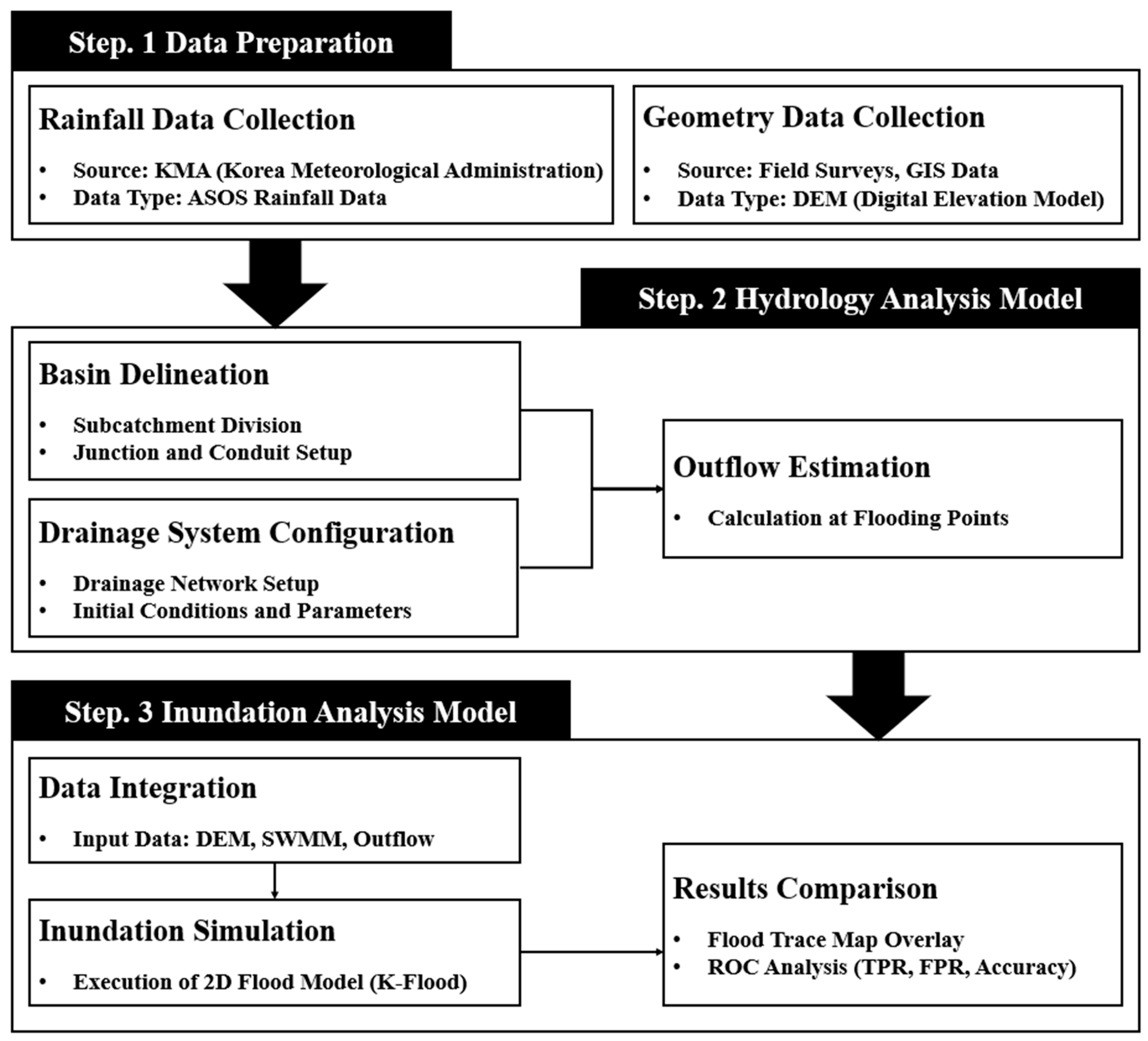
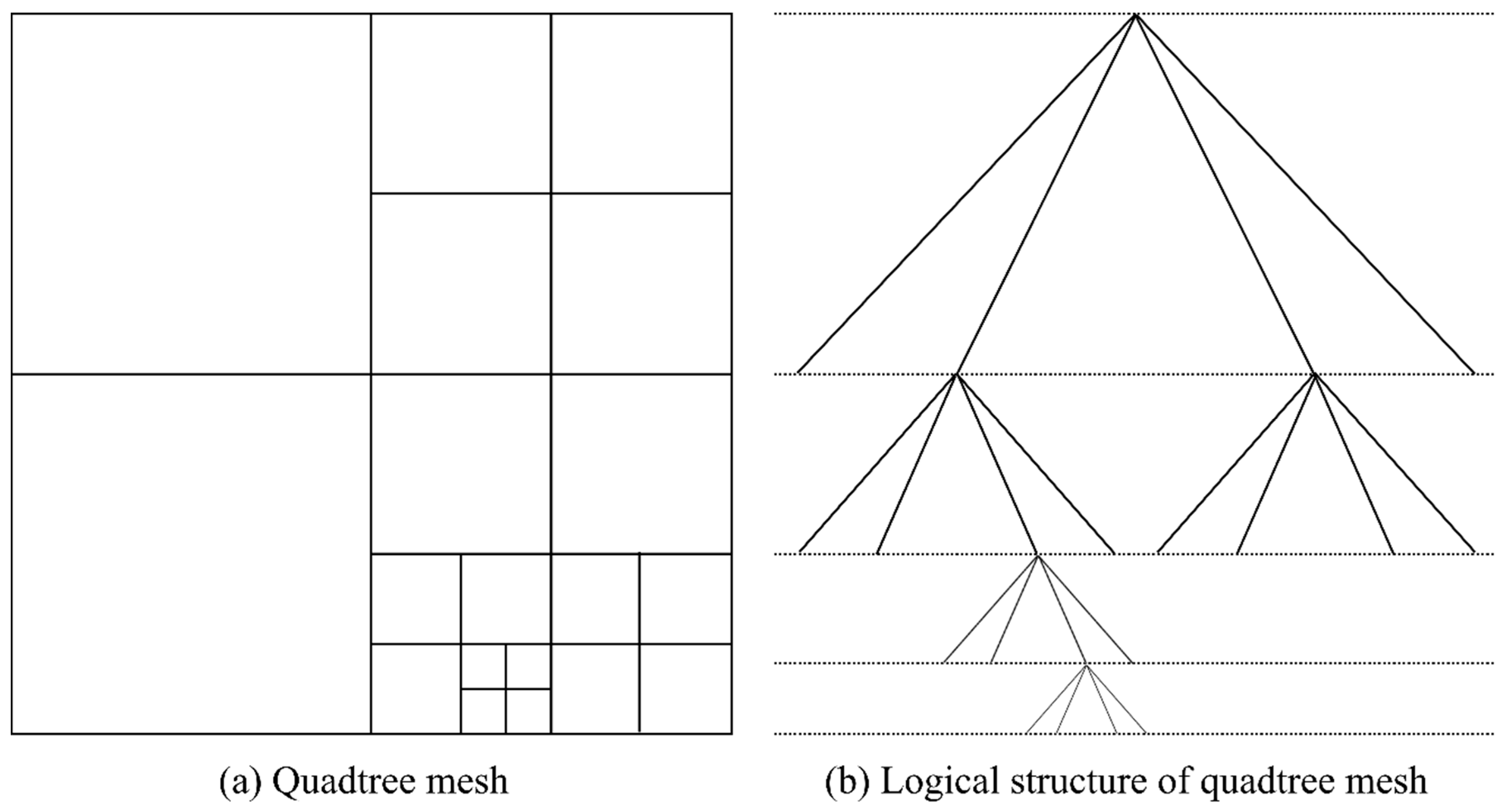
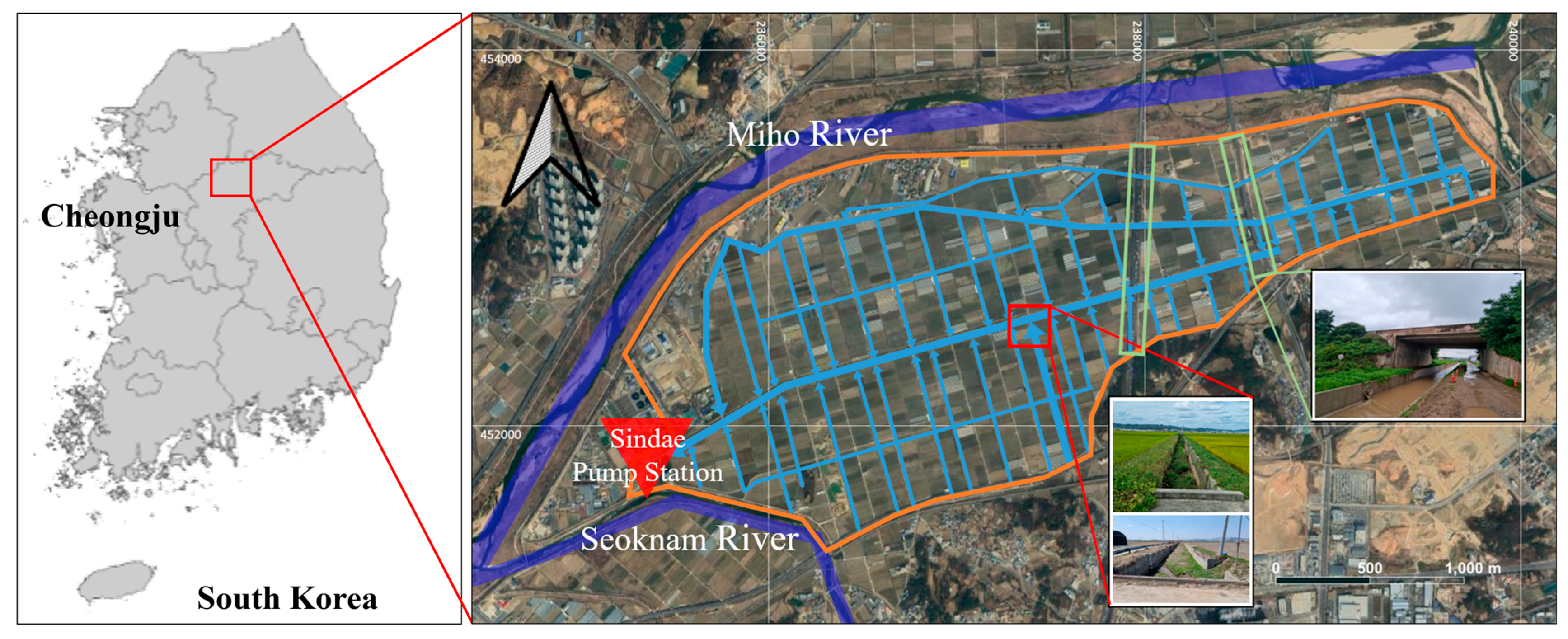
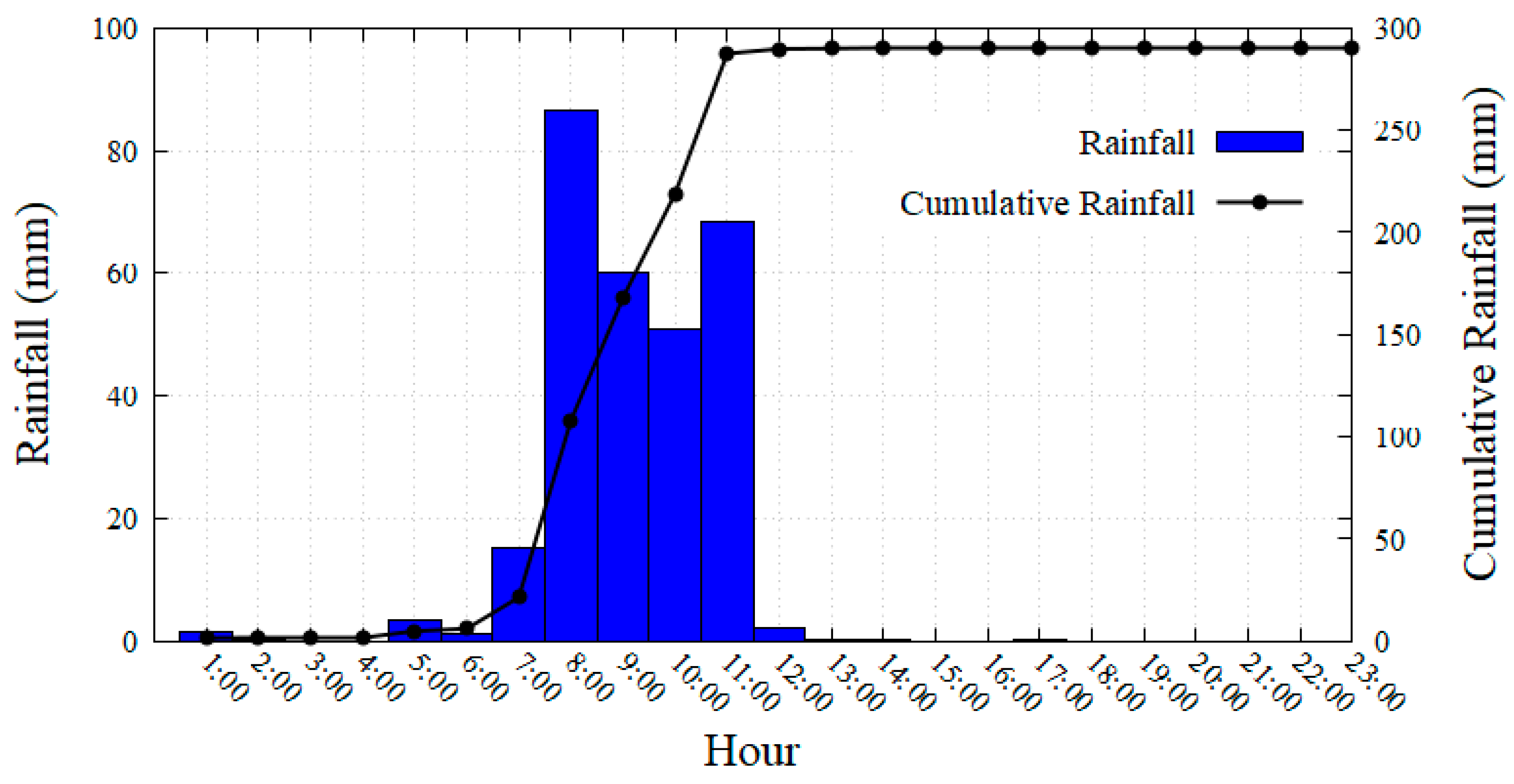

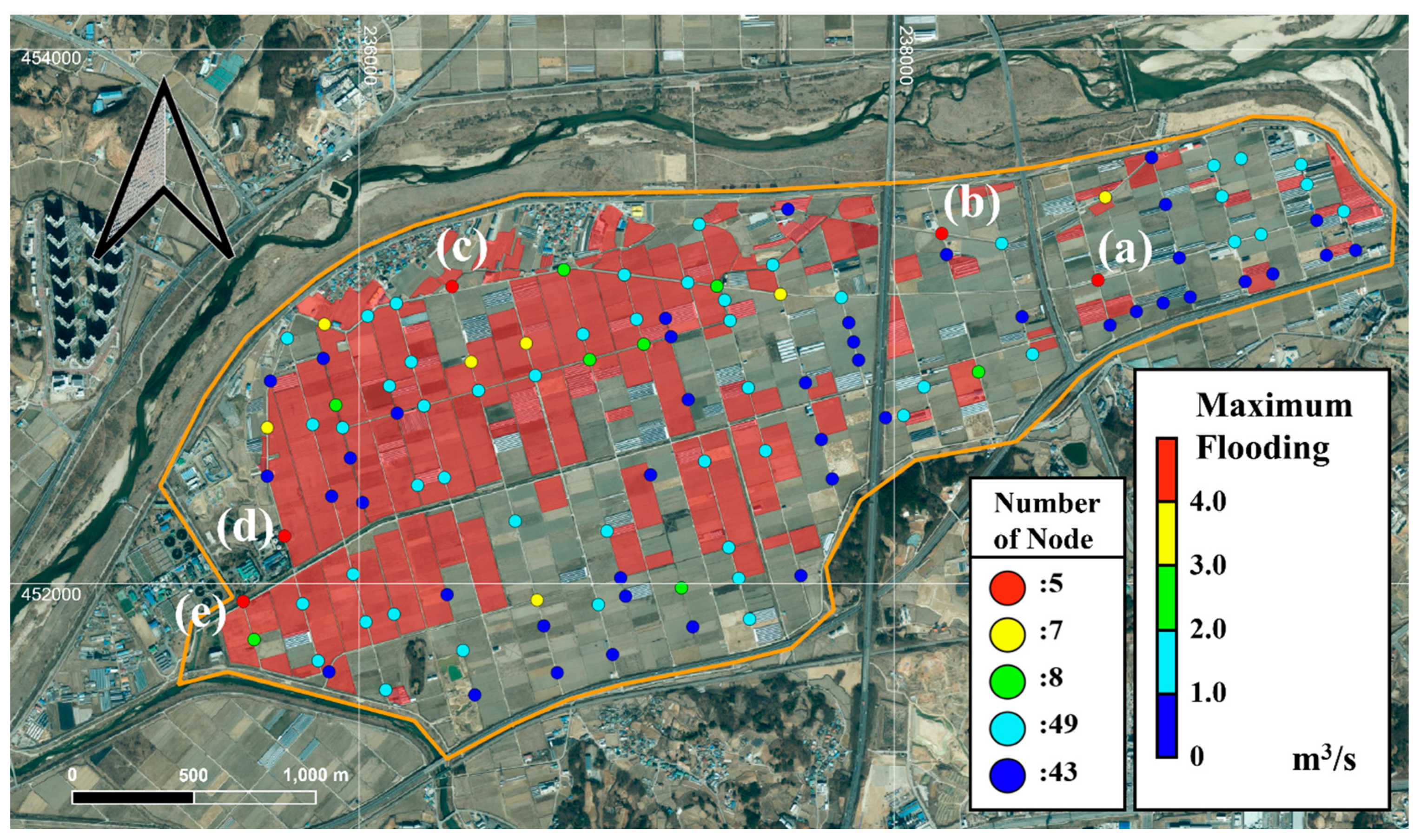
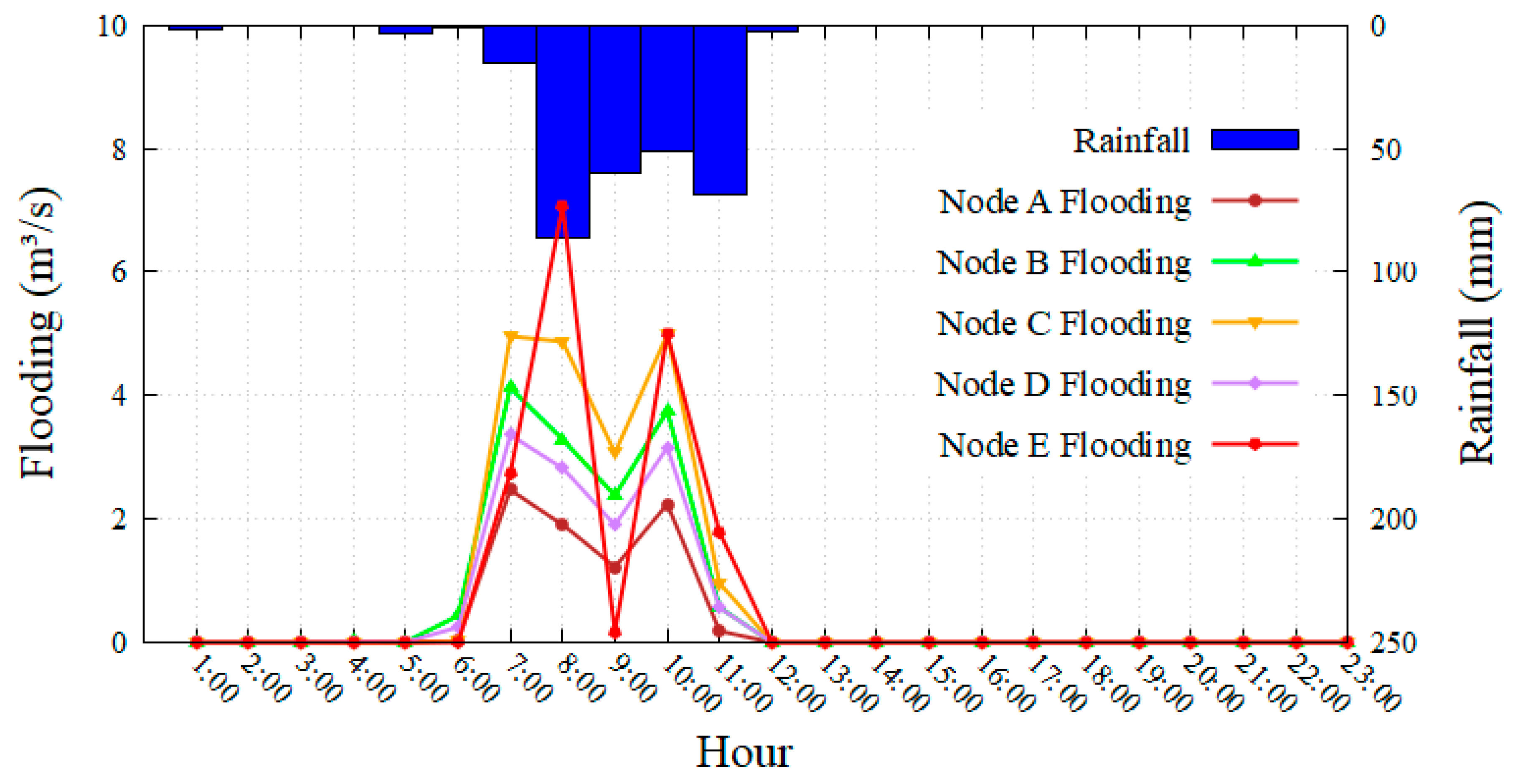

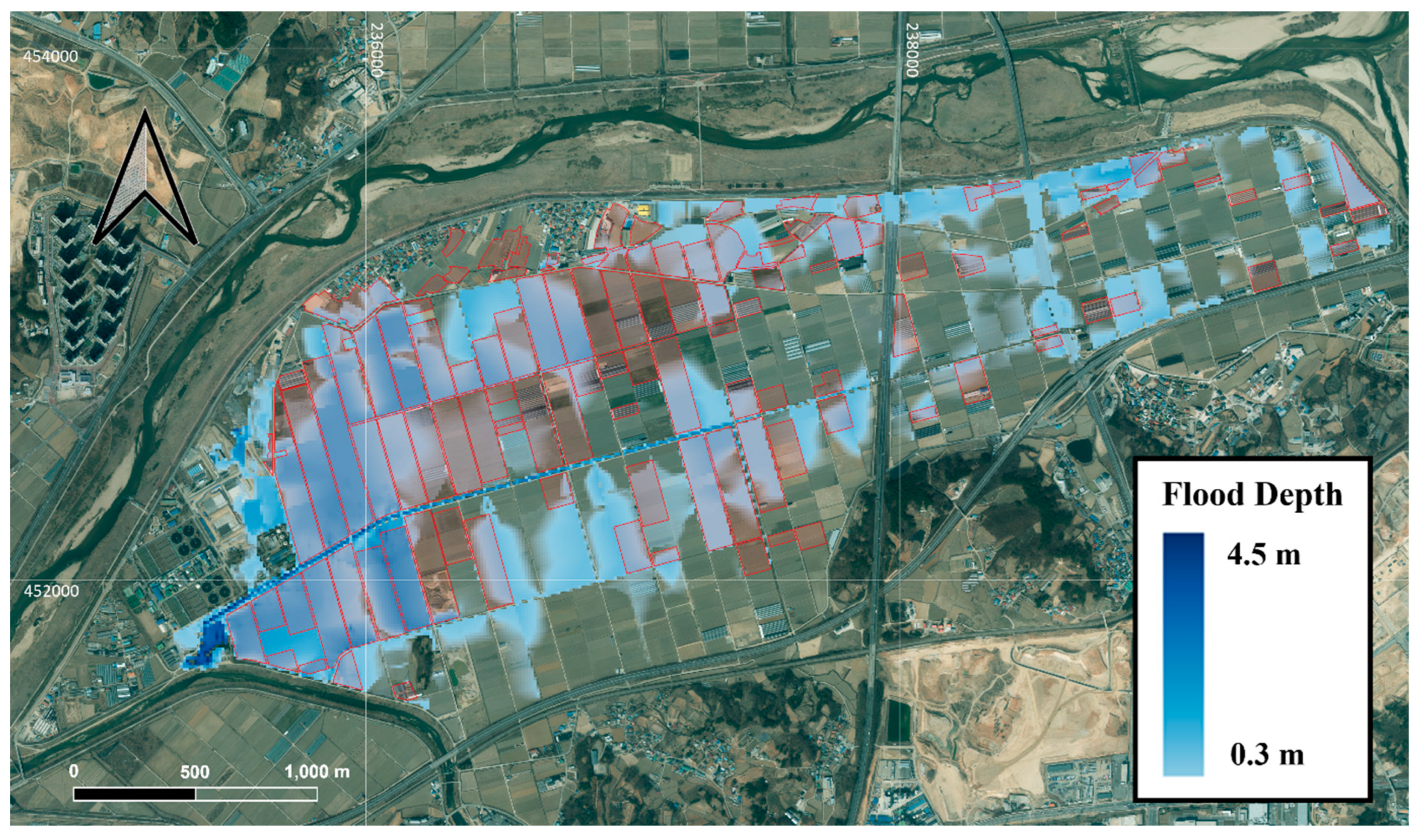

| Surface Type | Manning’s n Value | Source |
|---|---|---|
| Impervious area (saturated surface of paddy fields) | 0.015 s/m1/3 | Chow (1959) [25] |
| Pervious area (berms, grass-covered margins, vegetated zones near drains) | 0.17 s/m1/3 | Chow (1959) [25] |
| Open channels (concrete-lined drainage channels) | 0.03 s/m1/3 | Chow (1959) [25] |
| Prediction | |||
|---|---|---|---|
| Positive | Negative | ||
| Actual | True | 0.91 km2 | 0.96 km2 |
| False | 0.71 km2 | 3.61 km2 | |
| Manning Coefficient | Pump Capacity | Width of Channels | |
|---|---|---|---|
| Original | 0.03 s/m1/3 | 21 m3/s | - |
| Case. 1 | 0.015 s/m1/3 | 21 m3/s | - |
| Case. 2 | 0.03 s/m1/3 | 50 m3/s | - |
| Case. 3 | 0.03 s/m1/3 | 21 m3/s | Doubled |
| Case. 4 | 0.015 s/m1/3 | 50 m3/s | Doubled |
| Flooding Area | Flooding Volume | |
|---|---|---|
| Original | 1.62 km2 | 1181.579 m3 |
| Case 1 | 1.46 km2 | 1171.796 m3 |
| Case 2 | 1.51 km2 | 1106.084 m3 |
| Case 3 | 1.35 km2 | 1133.474 m3 |
| Case 4 | 0.99 km2 | 719.741 m3 |
Disclaimer/Publisher’s Note: The statements, opinions and data contained in all publications are solely those of the individual author(s) and contributor(s) and not of MDPI and/or the editor(s). MDPI and/or the editor(s) disclaim responsibility for any injury to people or property resulting from any ideas, methods, instructions or products referred to in the content. |
© 2025 by the authors. Licensee MDPI, Basel, Switzerland. This article is an open access article distributed under the terms and conditions of the Creative Commons Attribution (CC BY) license (https://creativecommons.org/licenses/by/4.0/).
Share and Cite
Song, I.; Lim, H.; An, H. Inland Flood Analysis in Irrigated Agricultural Fields Including Drainage Systems and Pump Stations. Water 2025, 17, 2299. https://doi.org/10.3390/w17152299
Song I, Lim H, An H. Inland Flood Analysis in Irrigated Agricultural Fields Including Drainage Systems and Pump Stations. Water. 2025; 17(15):2299. https://doi.org/10.3390/w17152299
Chicago/Turabian StyleSong, Inhyeok, Heesung Lim, and Hyunuk An. 2025. "Inland Flood Analysis in Irrigated Agricultural Fields Including Drainage Systems and Pump Stations" Water 17, no. 15: 2299. https://doi.org/10.3390/w17152299
APA StyleSong, I., Lim, H., & An, H. (2025). Inland Flood Analysis in Irrigated Agricultural Fields Including Drainage Systems and Pump Stations. Water, 17(15), 2299. https://doi.org/10.3390/w17152299






